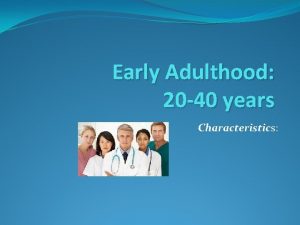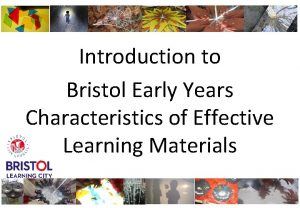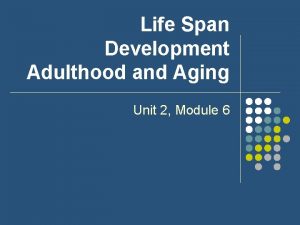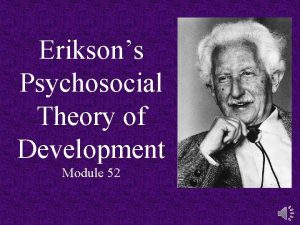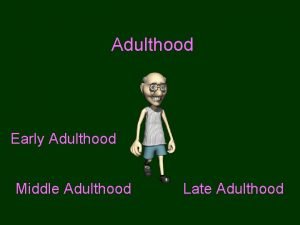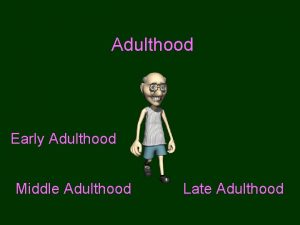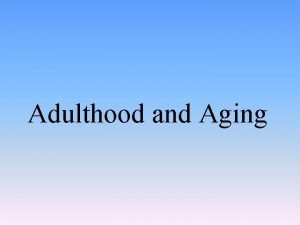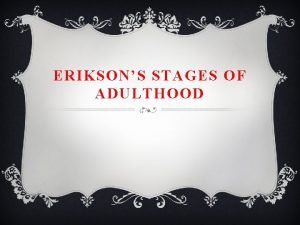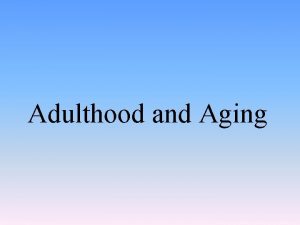Early Adulthood 20 40 years Characteristics Early Adulthood








- Slides: 8

Early Adulthood: 20 -40 years Characteristics:

Early Adulthood � 1. At 30 yr. of age , there is a period of reappraisal of one’s life � 2. The adult’s role in society is defined, physical development peaks, and the adult become independent. �Responsibilities and relationships � 1. The development of an intimate (e. g. close, sexual)relationship with another person occurs. �According to Erikson, this is the stage of intimacy versus isolation; if the person does not develop and sustain an intimate relationship by this age of life, he/she may experience emotional isolation in the future.

� 3. In the US, by 30 yr. of age, most Americans are married and have children. � 4. During their middle thirties, many women alter their lifestyle by returning to work or school or by resuming their careers.

Middle Adulthood 40 -65 Years o The person in middle adulthood possesses more Power and Authority than at other life stages. o A. RESPOSIBILITIES: the individual either maintain a continued sense of productivity or develops a sense of emptiness (Erikson’s stage of generativity versus stagnation. ) o B. 70% to 80% of men in their middle forties or early fifties exhibit a Midlife Crisis, this may lead to: o 1. A change in profession or lifestyle. o 2. Infidelity. Separation or divorce. o 3. Increased use of alcohol or drugs. o 4. Depression. o B. Midlife crisis is associated with an awareness of one’s own aging and death and severe or unexpected lifestyle changes (e. g. , death of spouse, loss of a job, serious illness).

�C. Climacterium; is the change in physiologic function that occur during midlife. � 1. In men, although hormone levels do not change significantly, a decrease in muscle strength, and sexual performance occurs in midlife. � 2. In women, menopause occurs: � 1 st The ovaries stop functioning and menstruation stops in the late forties or early fifties. � 2 nd Absence of menstruation for one year defines the end of menopause. � 3 rd Vasomotor instability, called hot flashes or flushes is a common physical problem seen in all women. in all countries and cultures , may continue for years.

Trust vs. Mistrust Birth-1 year Erikson believes that a basic attitude of trust or mistrust is formed at this stage. Trust is established when babies are given warmth, touching , love and physical care. Mistrust is caused by inadequate or inconsistent care and by parents who are cold, indifferent, or rejecting. Basic mistrust may later cause insecurity, suspiciousness or an inability to relate to others Autonomy vs. Children must learn to be “autonomous”-express their Shame and growing self control-to feed and dress themselves, and Doubt 1 -3 yr. look after their own hygiene and so on. Faliure to achieve the independency may force the child to doubt her/his own abilities and feel shameful about her actions. Initiatives Vs. Guilt 3 -6 years During this stage, children are exploring the world around them by playing and interacting with others. Through play they learn to make plans and carry out tasks. Parents reinforce initiatives by giving children freedom to play, ask questions and choose activities. Feelings of guilt about initiating activities are formed if parents criticize severely, prevent play or discourage the child’s question.

Industry vs. Inferiority 6 -12 years. Many events in middle childhood are symbolized by the day when you first entered school. The “elementary” school years are a child’s “entrance into life”. In school, children begin to learn skills valued by society, and success or faliure can affect a child’s feelings of adequacy. Children learn a sense of industry if they win praise for productive activities, such as reading, studying and painting. If a child’s efforts are regarded as messy, childish or inadequate, a feelings of inferiority result. For the first time, teachers, classmates, and adults outside the home become as important as parents in shaping attitudes toward oneself. Identity vs. Role Confusion. 12 -20 years. This is the crossroad between childhood and adulthood. The adolescent struggle with the question “Who am I? ” Adolescent must make a conscious search for identity. This built on the outcome and resolution to conflict in earlier stages. Identity is how you see yourself, and how you feel the rest of the wold perceive you. Identity define who you are, what you value, and commitments to work, personal relationships , sexual orientation and ideals.

Intimacy vs. Isolation 20 -40 yr. Young Adulthood. The primary task at this stage is to build deep friendships and to achieve a sense of love and companionship with another person. Intimacy=the ability to care about others and to share experiences with them. Feelings of loneliness or isolation are likely to result from an inability to form friendship or an intimate relationship. Key social agents are lovers, spouse and close friends (of both sexes) Generativit y versus Stagnation 40 -65 yr. Middle Adulthood At this stage adults face the task of becoming productive in their work and raising their families or by helping other children(as a teacher e. g. ). These standards of generativity are defined by one’s culture. Those who are unwilling or unable to assume these responsibilities will become stagnated and/or self-centred. Significant social agents are the spouse, children and cultural norms. Integrity vs. The older adult will look back at life viewing it as either Despair meaningful, productive and happy experience or a major > 65 years. disappointment full of unfulfilled promises and unrealized goals. One's self-experience, particularly social experience will determine the outcome of this final life crisis.
